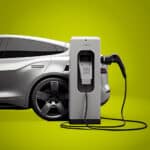Isabella from western North Carolina shares how she got fed up with high repair costs on her old gas car and made the switch to an EV. For many drivers, the total cost of an EV now beats a conventional gas car. Read why she’s never looked back.
——
We’ve all been there. An illuminated engine light in your once dependable, but now old car, signaling another costly visit to the mechanic. Eventually, my 13-year-old gas car demanded more repairs than it was worth. Since I try to live sustainably, I had been thinking about making the switch to an electric vehicle (EV) for my next car. Honestly, I’d prefer to live in a walkable “15-minute city” without a car, but for now, an EV was my preferred compromise.
I made the switch to an EV about six months ago. My 13-year-old gas car needed more repairs than it was worth.
So, when I started looking for a replacement about six months ago, the prospect of lower operating costs, the freedom from gas station detours, and minimal engine upkeep drew me in. I’d heard recommendations from a few friends about budget-friendly used EV options, so then the deal was sealed.
But just because I was ready to make the switch doesn’t mean I didn’t have some hesitations just like anyone else. Range anxiety, charging speed, and accessibility were top of mind during my research. Surprisingly, I’ve found charging spots are more abundant than I thought and are often free! My EV has over 200 miles of range, so it turned out day-to-day trips are a breeze, though I do need to plan more for longer road trips. I live in the mountains of North Carolina and I easily navigate daily life in my EV for grocery runs, coffee shop visits, and spontaneous day trips to hikes along the Blue Ridge Parkway.
People always ask me about charging. Currently, I mostly charge at home with a Level 1 charger via a 120V outlet (Level 1 via 120v outlet is a regular household power outlet like you would plug a lamp into). Occasionally I top-up at grocery stores too. I currently rent (my place has solar panels by the way, which significantly reduces my energy bills each month), but if I owned my home, a Level 2 charger would be one of the first upgrades I’d make. The efficiency of Level 2 chargers is a game-changer for when I need a faster boost.
I certainly benefited from talking with friends about making the switch to an EV before I bought it. One key bit of advice for someone considering an EV is to thoroughly research available models, charging infrastructure in your area, and potential financial incentives. Dive into analyses, compare models, and tap into the experiences of friends who’ve already embraced the EV lifestyle. I did tons of online research between different types of EVs and hybrids, and real-world insights made the decision-making process much easier.
One challenge I faced when going electric is the ability to take advantage of a tax rebate. When I bought my EV last year, I learned too late it was a non-refundable tax credit (which means it can lower your tax liability, but you won’t get any overflow of the credit refunded once your liability hits zero). So it’s important to factor that into your purchase decision.
As I use my EV primarily for day-to-day tasks, the reduced upkeep and environmental benefits are still appealing and benefit me every day. If I have the budget for an extended-range electric vehicle with fast charging capabilities, there is no doubt my next car will be an EV. It’s all about finding the right fit for your lifestyle.
Note from Gen180: The federal Inflation Reduction Act (IRA) provides incentives up to $7,500 per vehicle to help Americans make the switch from gas to electric. As of Jan. 1, the federal government updated its purchase incentive rules to include which vehicles qualify for the tax credit. Only seven models from four manufacturers (Ford, GM, Tesla, and Rivian), plus some plug-in hybrids (PHEVs), now qualify for the full $7,500 credit.
Some electric and PHEVs models are still eligible for some portion of the tax credit. Additionally, to help reduce the upfront purchase price, buyers can have the tax credit applied at the point of sale (as a discount at registered dealers) rather than waiting to file for a tax credit next year. Plus, if you plan to lease your next EV, you can also take advantage of the credit on a larger number of EVs. Learn more about tapping this benefit here.















